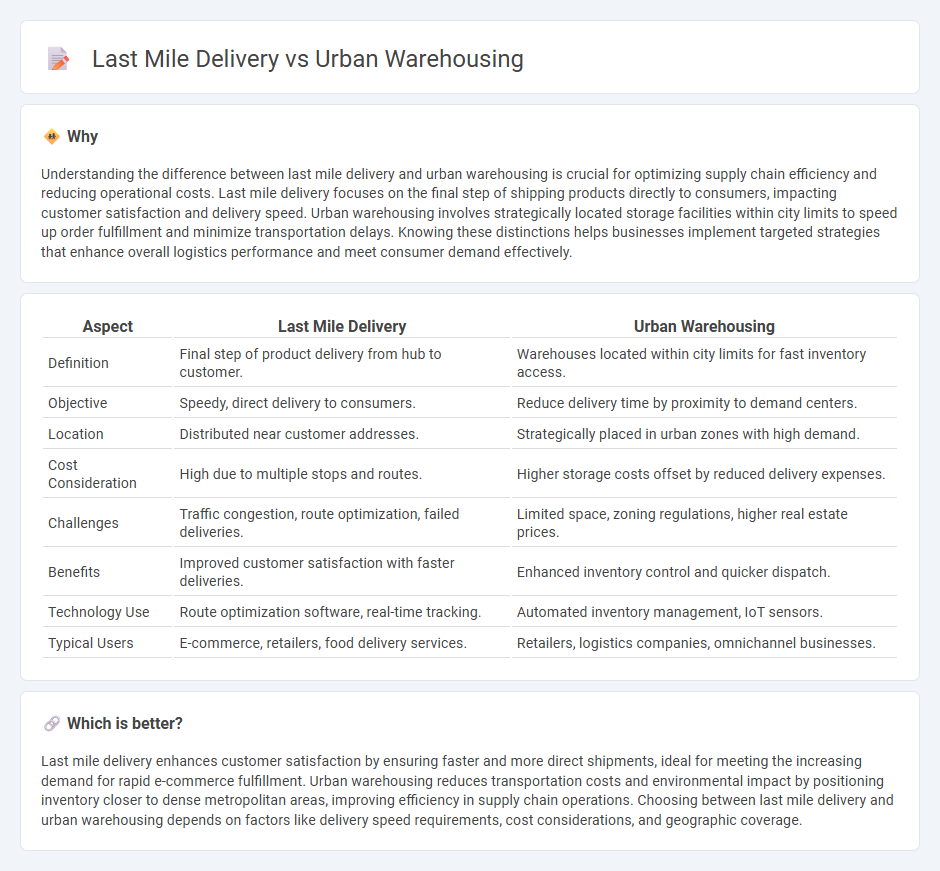
Last mile delivery focuses on the final step of the supply chain, ensuring packages reach customers quickly and efficiently, often within urban centers where demand is highest. Urban warehousing complements this by strategically locating storage facilities closer to consumers, reducing transit times and logistics costs. Explore the latest strategies in last mile delivery and urban warehousing to enhance your supply chain effectiveness.
Why it is important
Understanding the difference between last mile delivery and urban warehousing is crucial for optimizing supply chain efficiency and reducing operational costs. Last mile delivery focuses on the final step of shipping products directly to consumers, impacting customer satisfaction and delivery speed. Urban warehousing involves strategically located storage facilities within city limits to speed up order fulfillment and minimize transportation delays. Knowing these distinctions helps businesses implement targeted strategies that enhance overall logistics performance and meet consumer demand effectively.
Comparison Table
| Aspect | Last Mile Delivery | Urban Warehousing |
|---|---|---|
| Definition | Final step of product delivery from hub to customer. | Warehouses located within city limits for fast inventory access. |
| Objective | Speedy, direct delivery to consumers. | Reduce delivery time by proximity to demand centers. |
| Location | Distributed near customer addresses. | Strategically placed in urban zones with high demand. |
| Cost Consideration | High due to multiple stops and routes. | Higher storage costs offset by reduced delivery expenses. |
| Challenges | Traffic congestion, route optimization, failed deliveries. | Limited space, zoning regulations, higher real estate prices. |
| Benefits | Improved customer satisfaction with faster deliveries. | Enhanced inventory control and quicker dispatch. |
| Technology Use | Route optimization software, real-time tracking. | Automated inventory management, IoT sensors. |
| Typical Users | E-commerce, retailers, food delivery services. | Retailers, logistics companies, omnichannel businesses. |
Which is better?
Last mile delivery enhances customer satisfaction by ensuring faster and more direct shipments, ideal for meeting the increasing demand for rapid e-commerce fulfillment. Urban warehousing reduces transportation costs and environmental impact by positioning inventory closer to dense metropolitan areas, improving efficiency in supply chain operations. Choosing between last mile delivery and urban warehousing depends on factors like delivery speed requirements, cost considerations, and geographic coverage.
Connection
Last mile delivery efficiency is significantly enhanced by urban warehousing, which positions inventory closer to end consumers, reducing delivery times and transportation costs. Urban warehouses act as decentralized hubs that support rapid order fulfillment in densely populated areas, addressing challenges like traffic congestion and limited storage space. This strategic integration improves customer satisfaction by enabling faster, more flexible delivery options in urban logistics networks.
Key Terms
Urban Warehousing:
Urban warehousing is a strategically located storage facility within or near city centers, designed to reduce delivery times and enhance inventory accessibility for e-commerce and retail businesses. It plays a crucial role in optimizing supply chains by minimizing transportation costs, improving order fulfillment speed, and supporting sustainable last mile logistics. Explore how urban warehousing can revolutionize your supply chain efficiency and meet growing consumer demands.
Micro-fulfillment Centers
Micro-fulfillment centers (MFCs) play a crucial role in bridging urban warehousing and last mile delivery by enabling rapid order processing within densely populated areas. These compact facilities use automation to maximize space efficiency and reduce delivery times, enhancing customer satisfaction and operational agility. Explore how MFCs transform urban logistics and drive the future of fast, cost-effective last mile delivery.
Inventory Positioning
Urban warehousing strategically positions inventory closer to high-demand areas, reducing delivery lead times and improving service levels in dense metropolitan markets. Last mile delivery leverages these urban warehouses to enhance speed and efficiency, minimizing transportation costs and addressing customer expectations for rapid fulfillment. Explore our detailed analysis to optimize your inventory positioning for superior supply chain performance.
Source and External Links
Urban Warehousing: What It Is, Characteristics, and Benefits - Urban warehouses are compact storage facilities within or near dense urban areas designed to enable faster delivery, support hyperlocal consumption, and use space efficiently through vertical warehousing, helping companies meet high urban consumer expectations and reduce carbon footprint.
Urban Warehousing: The New Frontier in Last-Mile Delivery - Urban warehousing addresses last-mile delivery challenges by locating inventory close to customers in cities, allowing faster deliveries and greater flexibility, but faces challenges such as high real estate costs and restricted vehicle access in dense urban settings.
Urban Distribution Centers: Benefits and Last-Mile Advantages - Urban distribution centers serve densely populated cities by consolidating inventory and fulfilling orders locally to reduce last-mile delivery costs and times, meeting the rising demand for same-day or next-day deliveries driven by e-commerce growth.
 dowidth.com
dowidth.com